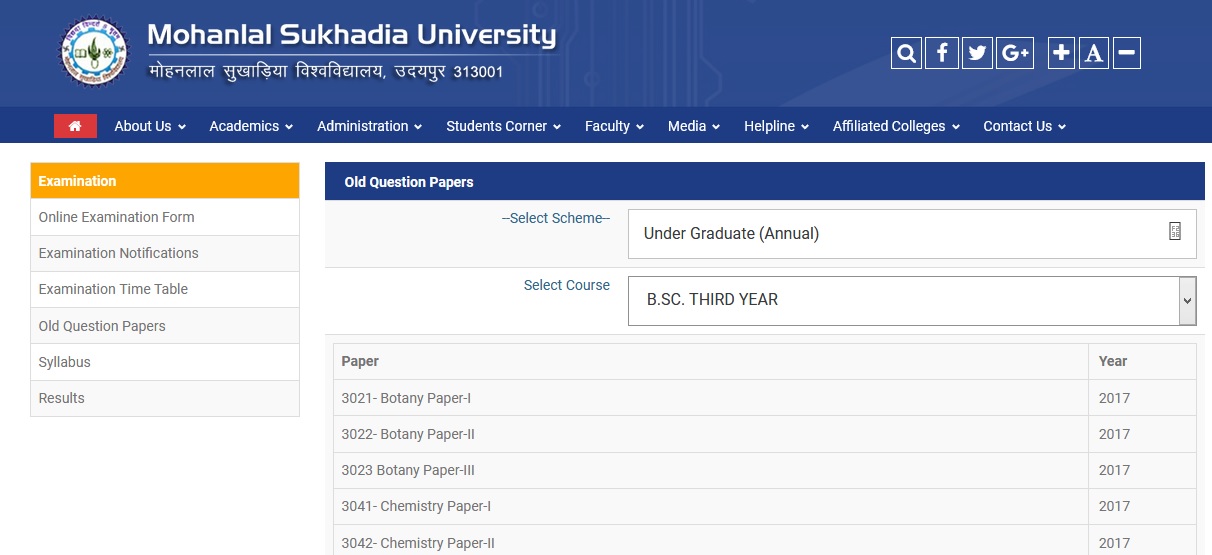Atomic & Nuclear Physics B.Sc Question Paper : mlsu.ac.in
University : Mohan Lal Sukhadia University
Degree : B.Sc
Subject : Atomic & Nuclear Physics
Year : III
Document Type : Question Paper
Website : mlsu.ac.in
Download Previous/ Old Question Papers :
https://www.pdfquestion.in/uploads/mlsu.ac.in/5808-3161e.pdf
MLSU Atomic & Nuclear Physics Question Paper
Final Year Examination of the Three -Year Degree Course, 2001
(Faculty of Science)
PHYSICS (Atomic & Nuclear Physics)
Related : Mohan Lal Sukhadia University Thermodynamics & Statistical Physics B.Sc Question Paper : www.pdfquestion.in/5803.html
Paper-I
Time : 3 Hours
Maximum Marks : 50
The candidates are requested to attempt FIVE questions in all taking at least ONE question from each unit. All questions carry equal marks.
UNIT-I
1. (a) Discuss early views on atomic structure with reference to Thomson and Rutherford modles. 2+3
(b) Derive the formula for the energy of an electron in the nth orbit of hydrogen atom accroding to the Bohr’s model.
2. (a) With the help of diagram explain the Franck and Hertz experiment. 6
(b) What are emission and absorption spectra- Give examples.

UNIT-II
3.(a) What are symmetric and antisymmetric wave-functions- What is their significance in defining the nature of particles- How do these lead to the Pauli exclusive principle- Explain. 2+2+2
(b) Explain why the X-ray spectra of elements of nearby atomic numbers are qualitatively very similar. What are Auger electrons-
4. (a) Discuss the periodic table of elements. 5
(b) What are the possible orientations of the total angular moments J for j=3/2 and l=1- Give the spectroscopic sysmbols.
UNIT-III
5. (a) Derive an expression for the rotational energy levels of a diatomic molecules about its centre of mass. 5
(b) A rotaional transition L=-1 to L =0 for the molecule CO has a measured absorption wavelength 2.60 mm. Calculate the moment of inertia and bond length ‘r’ for the CO molecules. 2.5+2.5
6. (a) Explain the mechanism of covalent bonding by giving suitable example. 4
(b) What gives rise to rotaional, vibration and electronic bonds in a molecules- 2+2+2
UNIT-IV
7. (a) Discuss the different terms in the Weizacker formula.
(b) What are the general characteristics of nuclear forces-
8.(a) Define mean or average life of a radioactive atom.What is decay constant- Give the relation between mean-life and decay constant. 2+2+4
(b) What is meant by range a-particles – 2
UNIT-V
9.(a) Describe a He-Ne laser. How is population inversion achieved in this type of laser- 7
(b) Give a few properties of a laser beam. 3
10. (a) Explain the meaning of :
(i) Strangeness. 2(ii) Isotopic spin. 2(iii) Hyper charge. 2
(b) What are Antiparticles- Does the neutron have an antiparticle –
Syllabus
Paper-I : 3161, Quantum mechanics and Atomic & Molecular Physics
Unit-I
Introductory Schrodinger theory :
Rise and fall of Plank-Bohr quantum theory Duality of radiation and matter, de Broglie‟s hypothesis, justification for the relation , experimental confirmation Phase and group velocities of a wave ; formation of a wave packet, illustrations.
Uncertainty principle relating to position and momentum, relating to energy and time, application complimentarity principle, photon interpretation of two slit interference, Einstein-de-Brroglie relations as a link between particle and wave properties, general equation of wave propogation, propogation of matter waves, time dependent and time independent schrodinger equations, physical meaning of ψ, conditions to be satisfied by schrodinger equation as an operator equation. Postulatery approach to wave mechanics, operators, observable and measurements.
Operators, eigen values and eigen functions; linear operators, product of two operators, commuting and non commuting operators, simulataneous eigen functions, orthogonal functions.Hermition operators, their eigen values, Hermition adjoint operators, expectation values of an operator.
Unit – II
Simple one dimensional problem ; particle in a box with rigid walls. Concept of a potential well. Wave functions and energies for the ground and excited states ; quantization of energy qualitative discussion of the solutions for a shallow potential well.
Application of Operator methods ; Simple harmonic oscillator, step-up and step-down operators, eigen functions and eigen values of the ground state and excited state, zero point energy probability density and its variations with degree of excitation ; orthogonality of wave functions.
Other one dimensional problems ; step potential, penetration through rectangular barrier. Transmission coefficients, barriers of special shapes, quantum mechanical tunneling, particle in of three dimensional cubical box, degeneracy.